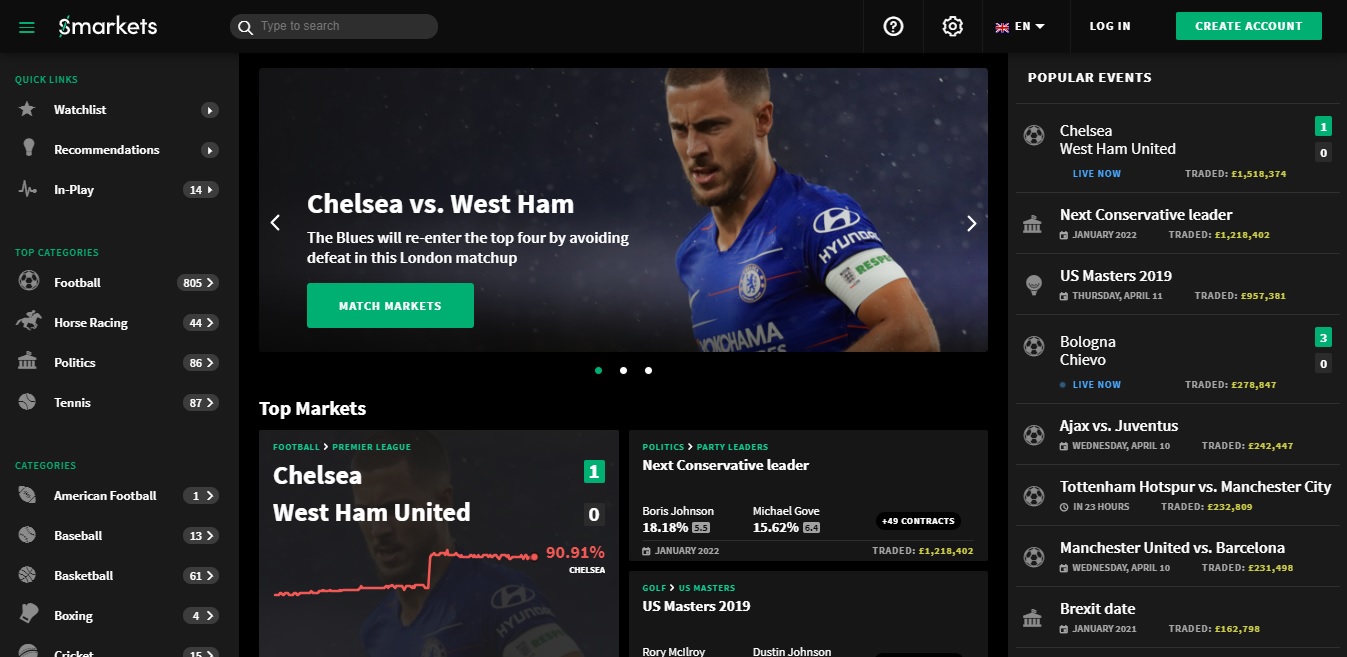Quick Cash Machine
Plus Edition

This is the Quick Cash Machine Plus Edition. This contains all the content of the basic edition plus upgrade content. Scroll down below to check out the upgrade content.
First Thing You Need To Know
Read through this guide entirely before starting.
We will be making our money with exchanges. What is an exchange? An exchange is a platform that allows users to place and take eachother's bets. Before we go any further, we need to understand that we are not betting whatsoever because we do not care about the eventual outcome of a game. What we are doing is making quick and easy trades. We get in at the right price then leave shortly after - making a profit after only a few minutes of work.
I will explain the most simple strategy you can do today!
We will be trading football (or soccer for that live outside of Europe). You do not need to know anything about football or trading whatsoever, everything you need to know will be explained below.
Each football match has many trading markets: as in bet on which team to win, bet on how many goals they will score, who will be the first goalscorer etc. For simplicity, we will only be trading on the under 2.5 goals market - this means we are trading our money where we hope to have 2 goals or less in a match.
Backing and Laying Bets
A bet can either be a back bet or a lay bet. A back bet means betting for a particular outcome to happen, a lay bet is betting on that same particular outcome to not happen. Remember that you are betting with other users on the platform when you are backing, someone has accepted your bets, when you are laying, you are accepting other people's bets. For example, Team A v Team B. The odds of Team A to win is 3.0. Here is what happens in all outcomes:
- If you placed a $/£10 back bet and Team A wins, you will receive $/£30 from other users accepting your bets (including your $/£10 stake back)
- If you placed a $/£10 back bet and Team A loses, you will lose my stake
- If you placed a $/£10 lay bet and Team A wins, you will lose $/£20 (the other person will receive $/£30 in total (your $/£20 plus their own $/£10 stake back))
- If you placed a $/£10 lay bet and Team A loses, you will receive the other person's $/£10 stake
If you look at it as a customer/bookmaker relationship, when backing, you are acting as a customer placing a bet. When laying, you are acting as the bookmaker taking the customer's bet and paying their prize if they win.
Don't be concerned if this sounds confusing at first, give it some time and you will understand because everything is quite simple.
This is just for your context. When trading we do not need to wait until the end of the game to profit, we can enter and exit the market at any point before and during the game that we feels would profit us the most.
Why The Under 2.5 Goals Market
In all markets, odds will go up and down. The odds of this market drops very quickly as the games progress if no goals are scored. We are relying on the odds to drop continuously so that when we exit, we make a profit! It's similar to trading in stocks, we buy a stock when it's cheap and watch as the prices increase, then we sell before it drops. Here the principle is the same except we want it to fall and then exit before it increases again!
How The Under 2.5 Goals Market Work
The markets will give this predetermined odds to reflect it's a prediction as to the likelihood of 2.5 goals (2 goals or more) being scored in the game. Odds of around 1.5 means there is a strong likelihood, 2.8 means less likelihood, 4.3 means unlikely and so on. You back and/or lay based on those odds. From the moment of kick-off in the game, the odds in this market will continue to fall because as the game progresses it is more likely that there will be under 2.5 goals. Once a goal has been scored the odds will increase but then slowly to fall again as the game continues. Our aim is to exit our trade at the right price before the 3rd goal is scored.
How The Trading Works
So far I have explained that you can back or lay the odds and implied that the odds are the same for both. The reality is that odds for backing and laying are different, lay odds tend to be slightly higher than the back and I will use this in the example below. This is not the most important factor but just to be aware of this fact.
When trading, we are entering and exiting at certain points before and during the game. Let me explain:
At 8pm, Team A will be playing against Team B. So before the game, approximately at 7.30pm, I place a $/£10 back bet on Team A at odds of 3.5 (the lay odds are different at 3.7). Around 15 mins into the game, the score is still 0-0, the lay odds have fallen to 2.7, so I decided to exit my bet at these lower odds. When exiting, you can either do this automatically or manually. By manually, you are laying $/£10 at 2.4, if automatically, the platform will do this for you if you choose to cash out.
When you trade out at lower odds you will immediately profit because when you back and lays odds become combined:
$/£10 x 3.5 back odds = $/£35 ($/£25 profit)
$/£10 x 2.7 lay odds = $/£27 ($/£17 liability)
$/£25 profit - $/£17 liability = $/£8 overall profit = 80% return
Although the odds can be different depending on the game, this is a realistic expectation on average across all games. You can definitely make a good profit within 15 minutes!
Before we continue, please take a moment to check out the latest product from one of our partners!
First Thing You Need To Know
Read through this guide entirely before starting.
We will be making our money with exchanges. What is an exchange? An exchange is a platform that allows users to place and take eachother's bets. Before we go any further, we need to understand that we are not betting whatsoever because we do not care about the eventual outcome of a game. What we are doing is making quick and easy trades. We get in at the right price then leave shortly after - making a profit after only a few minutes of work.
I will explain the most simple strategy you can do today!
We will be trading football (or soccer for that live outside of Europe). You do not need to know anything about football or trading whatsoever, everything you need to know will be explained below.
Each football match has many trading markets: as in bet on which team to win, bet on how many goals they will score, who will be the first goalscorer etc. For simplicity, we will only be trading on the under 2.5 goals market - this means we are trading our money where we hope to have 2 goals or less in a match.
Backing and Laying Bets
A bet can either be a back bet or a lay bet. A back bet means betting for a particular outcome to happen, a lay bet is betting on that same particular outcome to not happen. Remember that you are betting with other users on the platform when you are backing, someone has accepted your bets, when you are laying, you are accepting other people's bets. For example, Team A v Team B. The odds of Team A to win is 3.0. Here is what happens in all outcomes:
- If you placed a $/£10 back bet and Team A wins, you will receive $/£30 from other users accepting your bets (including your $/£10 stake back)
- If you placed a $/£10 back bet and Team A loses, you will lose my stake
- If you placed a $/£10 lay bet and Team A wins, you will lose $/£20 (the other person will receive $/£30 in total (your $/£20 plus their own $/£10 stake back))
- If you placed a $/£10 lay bet and Team A loses, you will receive the other person's $/£10 stake
If you look at it as a customer/bookmaker relationship, when backing, you are acting as a customer placing a bet. When laying, you are acting as the bookmaker taking the customer's bet and paying their prize if they win.
Don't be concerned if this sounds confusing at first, give it some time and you will understand because everything is quite simple.
This is just for your context. When trading we do not need to wait until the end of the game to profit, we can enter and exit the market at any point before and during the game that we feels would profit us the most.
Why The Under 2.5 Goals Market
In all markets, odds will go up and down. The odds of this market drops very quickly as the games progress if no goals are scored. We are relying on the odds to drop continuously so that when we exit, we make a profit! It's similar to trading in stocks, we buy a stock when it's cheap and watch as the prices increase, then we sell before it drops. Here the principle is the same except we want it to fall and then exit before it increases again!
How The Under 2.5 Goals Market Work
The markets will give this predetermined odds to reflect it's a prediction as to the likelihood of 2.5 goals (2 goals or more) being scored in the game. Odds of around 1.5 means there is a strong likelihood, 2.8 means less likelihood, 4.3 means unlikely and so on. You back and/or lay based on those odds. From the moment of kick-off in the game, the odds in this market will continue to fall because as the game progresses it is more likely that there will be under 2.5 goals. Once a goal has been scored the odds will increase but then slowly to fall again as the game continues. Our aim is to exit our trade at the right price before the 3rd goal is scored.
How The Trading Works
So far I have explained that you can back or lay the odds and implied that the odds are the same for both. The reality is that odds for backing and laying are different, lay odds tend to be slightly higher than the back and I will use this in the example below. This is not the most important factor but just to be aware of this fact.
When trading, we are entering and exiting at certain points before and during the game. Let me explain:
At 8pm, Team A will be playing against Team B. So before the game, approximately at 7.30pm, I place a $/£10 back bet on Team A at odds of 3.5 (the lay odds are different at 3.7). Around 15 mins into the game, the score is still 0-0, the lay odds have fallen to 2.7, so I decided to exit my bet at these lower odds. When exiting, you can either do this automatically or manually. By manually, you are laying $/£10 at 2.4, if automatically, the platform will do this for you if you choose to cash out.
When you trade out at lower odds you will immediately profit because when you back and lays odds become combined:
$/£10 x 3.5 back odds = $/£35 ($/£25 profit)
$/£10 x 2.7 lay odds = $/£27 ($/£17 liability)
$/£25 profit - $/£17 liability = $/£8 overall profit = 80% return
Although the odds can be different depending on the game, this is a realistic expectation on average across all games. You can definitely make a good profit within 15 minutes!
Before we continue, please take a moment to check out the latest product from one of our partners!
A Few Things You Must Understand About Risk
There is always a risk that goals are scored and the odds increasing, thereby making your lay bets more expensive and less profitable. So although this is not risk-free, the risk is minimal, and if you follow my guide carefully, you will end up with long-term profit even when taking into account your risk. Let me explain:
You can expect to make between 0-90% return across all games. The reasonable average is 40% return.
- 3 goals or more happen in 1 out of 12 games = here you will lose no matter what if you don't exit
- 2 goals or more happen in 1 out of 8 games = here you can still win at the end of the game or exit at the right price but this can be tricky to wait for the right price
- 1 goal happens in 1 out of 5 games = here you can still win at the end of the game or exit at the right price but you may have to wait a bit longer
- A first goal becomes scored on average within the first 30 mins of a game = 30 mins is plenty of time to trade in and trade out for a good profit at the right price before the first goal is scored
As a personal rule of thumb, I like to exit when the odds fall between 0.5 and 1.5, so if I trade in at 2.5, I will wait until it falls between 2.0 and 1.0 before I trade out - this usually yields around 20% to 80% return, in other words, if I trade in and out with $/£10, I can expect $/£2 to $/£8 profit. Odds usually drop between 0.5 to 1.5 with 15 mins, and as mentioned above, the average goal scored is within 30 minutes, so it gives you plenty of time to exit before the goal is scored. Don't despair if a goal is scored before you exit, these averages provide you with a profitable expectation long-term, so if you follow this strategy across a large number of games, you will be profitable in the long-term.
What Happens If
- The first goal is scored - you can either exit for a small loss or stick with it and allow the odds to fall again until you get the right odds before you exit
- The second goal is scored - Same as the above although it would be harder to get the right odds unless you are near the end of the game, or you can wait until the game if is finished - you may still win this just like a normal bet if no more goals are scored
Beginner Recommendations
This can certainly be scaled, start off with $/£1 stakes in order to get comfortable with this strategy then slowly increase the stakes as you gain more experience. Most people that have followed this strategy eventually moved onto trading around $/£200 and making around $/£20 to $/£160 per in less than 30 mins.
The longer you stay in the market without any goals, the more the odds fall in your favor, however, at any time that first goal can be scored increasing the odds. Trade out at a predetermined time even if it means making a loss. In the beginning, you are learning the process and being comfortable with trading. Learn to trade methodically not emotionally. Once you become more familar and confident, then you can experiment by staying in the market longer.
Trade as many football games as you can. The aim is positive expectation, which only becomes realized across a large number of games. You will experience profits and losses but if you trade long-term across many games, the profit will heavily outweigh the losses.
Treat everything as a learning curve. Don't be phased by losing, as long as you stick within the guidelines, you will be profiting long-term.
Set a strict rule for yourself. Decide when you exit your trade. For me, I like to exit within 30 minutes or if the odds fall by at least 1.0 because I know on average the first goal occurs within 30 minutes of the game or I like my price to be at least 1.0 cheaper, whichever occurs first. By setting your own rule, you have something easy to follow for every match and you are not driven by emotion which can lose you a lot of money. I don't mind losing money on a few games as long as I stick with my own set of rules because those rules are predictable and profitable in the long-term.
Trading Walkthrough
Below I have provided a short walkthrough of one of my trades. For simplicity and demonstration, I have staked £1, as I would expect you would also start off with smaller stakes to understand the process and scale up your stakes once you become more confident.
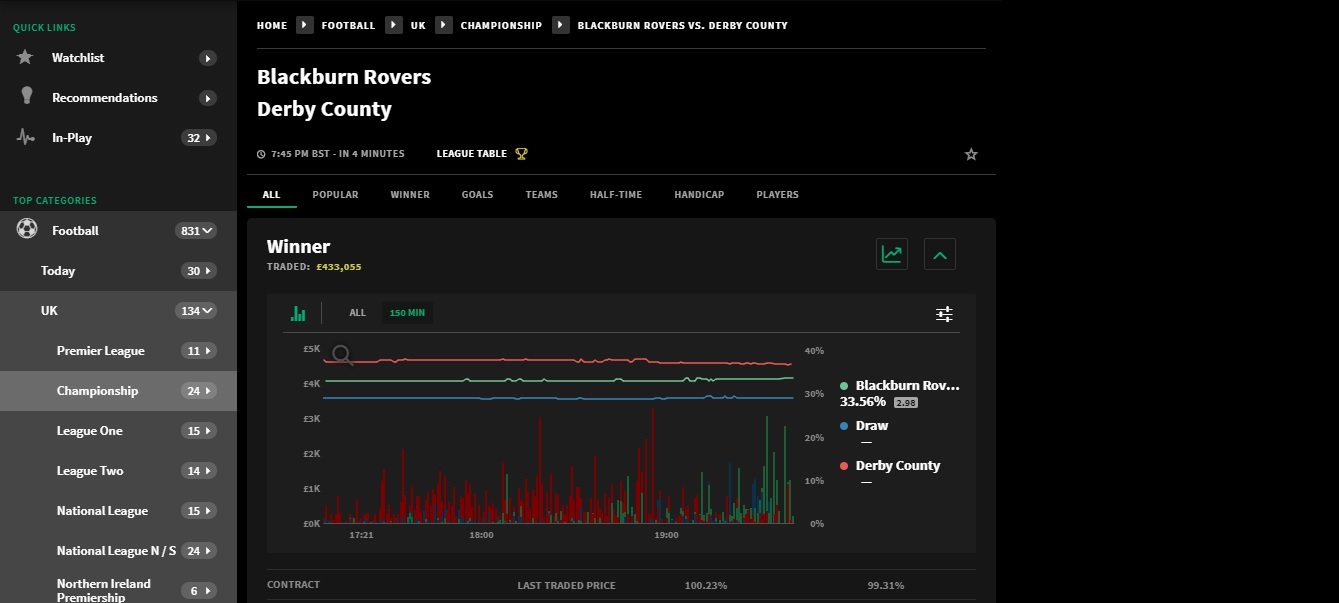
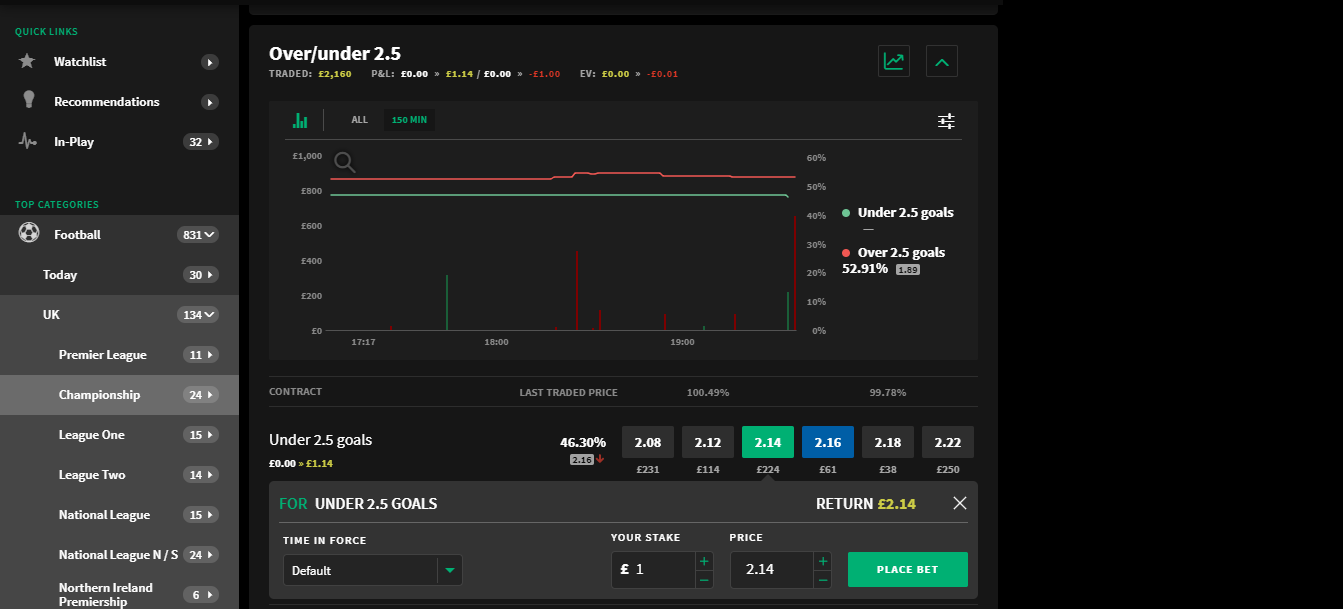
As you can see, I will be trading on Blackburn v Derby, due to kick off at 7.45pm, so shortly before the game, I scrolled down to the Under 2.5 Goals market and placed a back bet of £1 at odds of 2.14. You can see that the back (2.14) and lay (2.16) odds are slightly different, this is normal. Remember, we enter into the market at the back odds and exit at the lay odds.
I enter into the market with a stake of £1 at odds of 2.14, meaning my return will be £2.14 (= £1.14 profit + my £1) if the game finishes under 2.5 goals. However, we know that I am not interested in waiting for the game to finish.
All I am interested in is waiting for the right time and price, then I will be exiting this market with a guaranteed profit!
So we wait .....
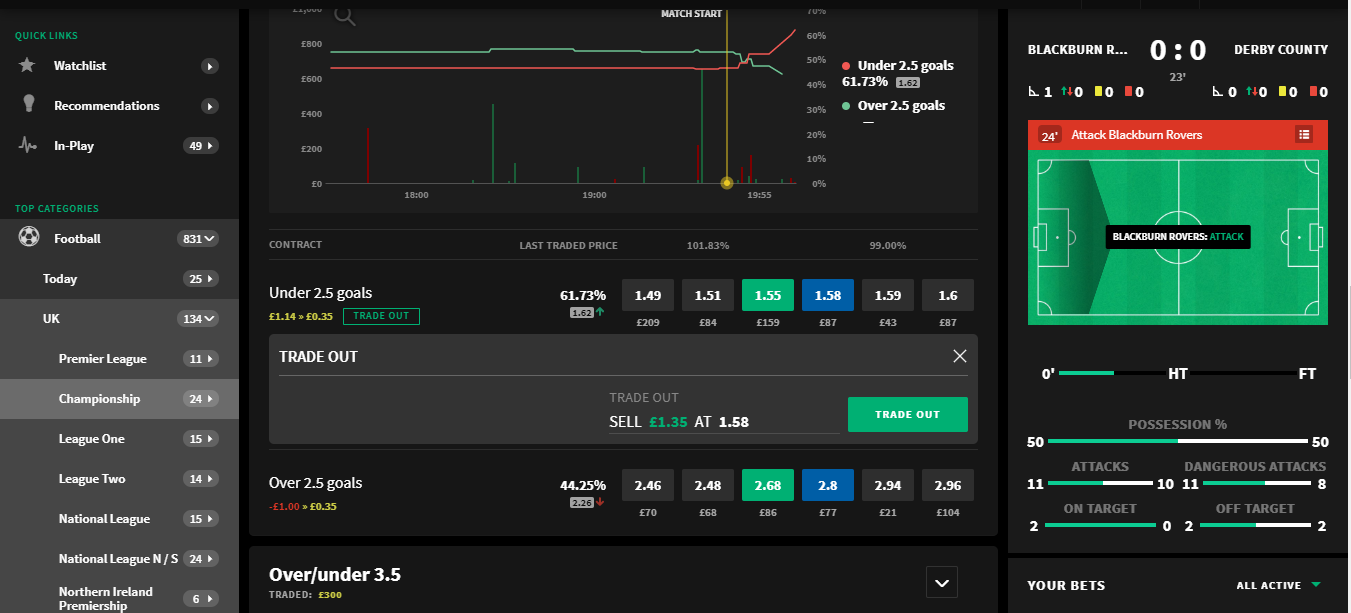
At 24 minutes into the game, the odds have fallen to where I like and so I decided that this is the right time to exit the trade. I simply clicked "Trade Out" and now my trade is completed! By trading out, the exchange will automatically bet against your first bet and calculate the profit or loss.
That's my trade for this game done!
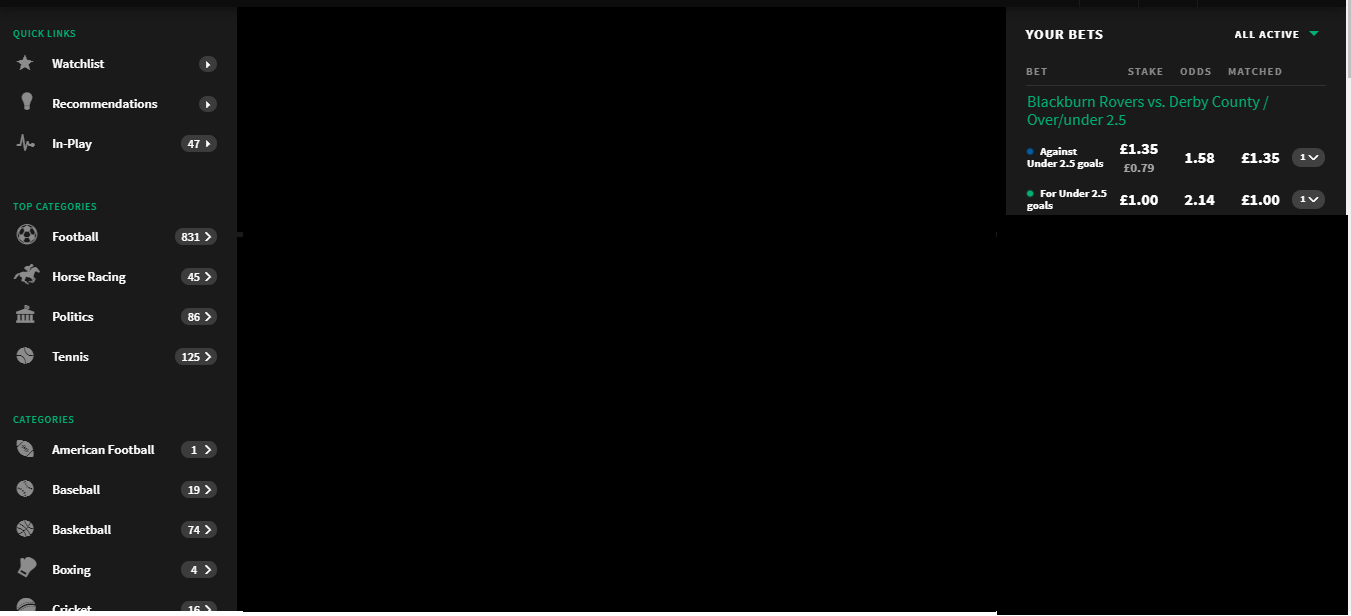
By trading out, I have bet against my earlier bet. My earlier bet was for 2.5 goals to happen. By trading out, I bet that 2.5 goals wouldn't happen. Both bets would cancel each other out, however, at differing odds, you would either end up with a profit or loss.
With my trade, by trading out I bet against my earlier bet, making both bets cancel each other, however, because I traded out at lower odds compared to my earlier bet, I leave this trade with a profit.
To help explain this, you can see under "Your Bets" that before the game started I backed for 2.5 goals at 2.14 odds, then after 24 minutes, I traded out, which meant I laid (bet against) 2.5 goals at 1.58 odds.
When calculating the trade out, the exchange will calculate the bets against each other. The exchange will automatically work out the lay bet and calculate both bets against eachother and release the profit into your account, no need to wait for the game to finish to receive your profit, but just to help you understand the calculations:
You need to know that liability (which is £0.79 in this trade) is what you need to pay on the lay bet should that lay bet loses.
The calculations are as follows:
£1 back @ 2.14 = £2.14 (= £1.14 profit + my £1)
£1.35 lay @ 1.58 = £0.79 liability (the exchange automatically worked out the lay stake and liability when traded out)
£1.14 - £0.79 = £0.35 overall profit on £1 stake = 35% return
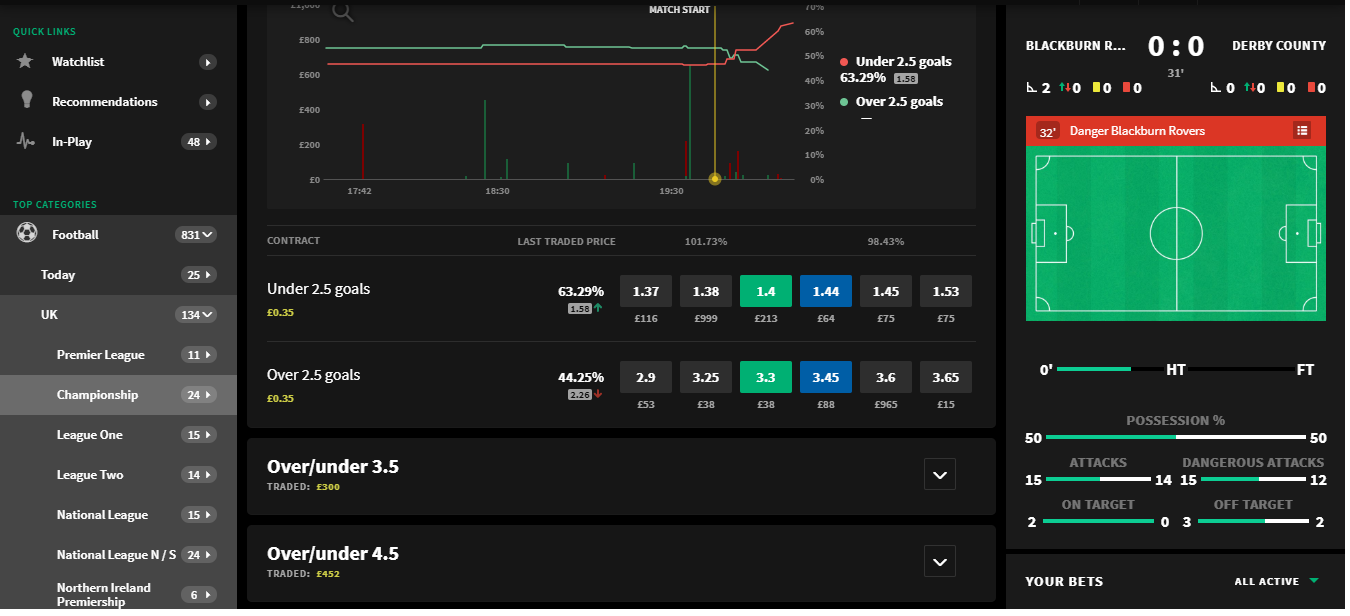
You can also see £0.35 in yellow, this means how much I had profited from this trade. Had I made a loss, the figure would be in red.
So you can see in just 24 minutes, I had made a 35% return on my stake. If I staked £10, my return would have been £3.50 or if I staked £100, my return would have been £35.00! You can keep scaling this up to where you are comfortable.
On this game, I disciplined myself that I would trade out within 30 minutes of the game or to the odds I like, whichever came first. I didn't care whether the odds would have fallen further had I stayed in longer because I remained disciplined to my own rules rather than trade emotionally.
You can see that at 32 minutes into the game the score was still 0-0 at half time and the odds had fallen further down to 1.44, but it didn't matter to me because the risk of staying in the trade longer would not be worth the risk if it was not part of my plan before I made that the trade. Only stay in the trade for as long as you planned to before you make that trade.
We do not need to care about the outcome of the game or how many goals are scored because once we exit we have made our money, so no matter the outcome, we are guaranteed a profit!
There are plenty of games available every day so you have plenty of opportunities for trading a profit!
I use this trading strategy every week, usually trading between $/£150 to $/£300 per game and easily make at least $/£2,500 per week even when taking into account games where I had lost!
Exchanges
The exchange I use and would highly recommend is Smarkets. The user interface is very easy to use and Smarkets has 100's of football games available to trade on every day!
Click here or the image or button below to sign up for a Smarkets account!
If Smarkets is not available where you are you can always use another exchange as they all work the same - simply Google "sportsbook exchange" and sign up to whichever exchange is available to you. If you have any issues, ask or email the exchange's support as I always find them very helpful.
Quick Cash Machine Plus Edition
Below is the content exclusive to this upgrade
Game Selection
Not all games are profitable. If you select the wrong game you may find it difficult to trade for various reasons, preventing from making a profit or even worse, taking an unnecessary loss! Therefore I have compiled a list of things to consider when selecting games to trade:
- High Liquidity. You will notice an amount of money displayed underneath the odds. For example, when looking at the markets, the odds may display 2.8 with $/£1,700 underneath, this figure is liquidity. Basically, it means the amount of money available to cover your bet. If I backed $/£100 at odds of 3.0 and the liquidity is $/£500 then my bet can be covered because my profit is potentially $/£200 ($/£300 - my $/£100 stake). However, is the liquidity is $/£120 then my bet cannot be fully covered and may not be accepted. If the markets do not have enough liquidity to fully cover your bet then your bet will only be partially covered or not covered whatsoever, preventing you from winning the full amount. My advice is to find games that have high enough liquidity to cover your potential profits
- High profile games. There are many leagues and levels in football, however, it would be wise to only trade on the higher profile games like the World Cup and Premier Leagues, and even League 1 games. Why? Because high profile games have high liquidity and are available almost daily every week, and you can easily find stats on games to gauge the likelihood of goals being scored. Lower league games aren't always available, have poor liquidity and have fewer stats records kept so it's harder to predict the likelihood of goals scored. Almost every country has its own premier league and league 1 games so there are no short of games to trade on each week
- High odds. It's natural to assume that low odds for Under 2.5 Goals are the best to select because there is a likelihood of it becoming true. This may be the case but we are not interested in what happens once the game finishes, we simply want to enter and exit before the game ends. The mistake with trading on low odds like 1.5 pre-game is that even if no goals are scored, the odds take longer to fall. However, higher odds like 2.5 fall much faster, and we make a profit when odds fall significantly. So I advise entering into the market at odds no lower than 2.0
- Even teams. When a team is a strong favorite then they are more likely to score. Although we are not afraid of a goal, ideally we want no goals for as long as we can. If odds of Team A are 1.4 and Team B are 5.8 then you know Team A is much stronger and more likely to score a goal. I advise choosing a game where both teams are roughly even. Team A at 2.7 and Team B at 3.2 would be a much better match because it means that both teams will fight hard for the ball and the pace of the game would be more back and forth without either team having a significant advantage
My Golden Tips For Trading
- Make a plan and stick with it. Decide how long you want to stay in the trade. It could be within 5 mins, 10 mins, 20 mins or even until half time. Or do you prefer to wait until the odds fall by 0.5, 1.0, 1.5 or 2.0? Exit at your planned time regardless of whether you made a profit or a loss. If you have made a loss, you can always adjust your plan on future games. Remember, we are looking to trade methodically, not emotionally, because trading emotionally is a sure-fire way of losing a lot of money!
- Always look at your trades across the long-term, don't look at the profit and losses of your trades individually. We are looking for expectation in the long-term. I will be happy to lose a little it of money on a trade if I knew I followed my own rule, however, I will be less happy if I made a profit by not following a rule that has made me money long-term in the past. Profit and loss will occur with each game but you need to look at your results long-term
- Learn as much as you can, as early as you can and as cheap as you can. Start with the smallest stakes, trade on as many good games as you can and learn to become confident with the method before increasing your stakes. You will always make mistakes no matter what, but if you learn them early then the likelihood of you making those same mistakes on higher stakes is minimal
- Increase your stakes gradually. It makes senses to take small steps to build your confidence. Trading from $/£1 stakes to $/£2 makes perfect sense. Jumping from $/£1 to $/£20 does not.
- Do your research. Perhaps not so important in the beginning while you are getting used to the trading method. But once you become more confident, it's then time to refine your trading and game selection. You do not need to know anything about football but it does help to research and understand some basic stats. Some teams and its players are more likely to score early goals and some are more likely to score late goals. For obvious reasons, we want to late scorers so that we can stay in our trades for as long as we can while the odds continue to fall before we exit prior to the first 1-2 goals. There are many resources that provide key stats on teams/players and their scoring tendencies. A simple Google search will bring up these resources
- Create a routine. Even though this method allows you to make a lot of money quite easily, it can be a repetitive task if done several times a week. It is important to set a routine for yourself including breaks. On some weeks, I decide to trade no more than 2-3 games per day or spend no more than 1 hour per day. Also, I do not stare at the screen continuously, if I'm in a trade, I will perhaps glance at the score every 5 mins whilst doing something else
By simply applying the above to your trades, you will find yourself making a lot more than $/£2,500 per week in the long-term!
Please take a moment to check out the latest products from our partners!

